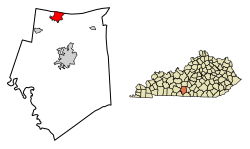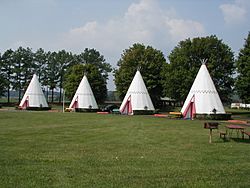Cave City, Kentucky facts for kids
Quick facts for kids
Cave City, Kentucky
|
|
|---|---|

Broadway in Cave City
|
|
| Motto(s):
"Home of Mammoth Cave"
|
|

Location of Cave City in Barren County, Kentucky.
|
|
| Country | United States |
| State | Kentucky |
| County | Barren |
| Area | |
| • Total | 4.43 sq mi (11.47 km2) |
| • Land | 4.41 sq mi (11.42 km2) |
| • Water | 0.02 sq mi (0.05 km2) |
| Elevation | 633 ft (193 m) |
| Population
(2020)
|
|
| • Total | 2,356 |
| • Estimate
(2022)
|
2,356 |
| • Density | 534.24/sq mi (206.27/km2) |
| Time zone | UTC-6 (Central (CST)) |
| • Summer (DST) | UTC-5 (CDT) |
| ZIP code |
42127
|
| Area code(s) | 270 & 364 |
| FIPS code | 21-13492 |
| GNIS feature ID | 0489114 |
Cave City is a small city in Barren County, Kentucky, in the United States. In 2020, about 2,356 people lived there. It is known as the "Home of Mammoth Cave" because it is very close to Mammoth Cave National Park. This park is famous for having the longest cave system in the world!
Contents
Where is Cave City Located?
Cave City is in the northwest part of Barren County. It's easy to get to, with major roads like U.S. Route 31W and Interstate 65 passing nearby. Interstate 65 is a big highway that helps people travel north to cities like Elizabethtown (about 44 miles away) and Louisville (about 85 miles away). It also goes southwest to Bowling Green (about 31 miles away) and Nashville, Tennessee (about 91 miles away).
The most exciting part about Cave City's location is its closeness to Mammoth Cave National Park. The park's main entrance is only about 10 miles west of the city. This makes Cave City a popular spot for tourists who want to explore the amazing caves. The city of Glasgow, which is the main town in Barren County, is about 10 miles southeast.
Cave City covers an area of about 4.4 square miles (11.4 square kilometers). Only a tiny part of this area is water.
A Look Back: Cave City's History
Cave City started because some people from Louisville wanted to create a resort town. This was in October 1853. They knew that Mammoth Cave was a big attraction, so they bought land near it. The town officially became a city in 1866.
The land for the town was first owned by James Perry in 1798. Over the years, it was sold a few times. Finally, a group called the Knob City Land Company bought a large piece of land. They paid a lot of money for it, showing how important they thought this location would be for a new town.
The Knob City Land Company planned out the town with wide main streets. Around the same time, the Louisville & Nashville Railroad built train tracks through Barren County. The first train arrived in Cave City in 1859. The town got its name from a small cave that was actually inside the town limits, not from the famous Mammoth Cave. A small stream flowed through this town cave, and the railroad used it for water.
The first business in Cave City was a store opened by Beverly Daniel Curd and his brother. Beverly Daniel Curd was also the first postmaster, moving the post office to Cave City in 1860. Another early business owner was Judge C. Roberts, who also built the first house. A fun fact is that the first woman to own a business in Cave City was April Houchens. She opened "Funny Hats and Bows," a unique shop that stayed open until 1985!
Who Lives in Cave City?
| Historical population | |||
|---|---|---|---|
| Census | Pop. | %± | |
| 1870 | 387 | — | |
| 1890 | 362 | — | |
| 1900 | 538 | 48.6% | |
| 1910 | 645 | 19.9% | |
| 1920 | 690 | 7.0% | |
| 1930 | 773 | 12.0% | |
| 1940 | 960 | 24.2% | |
| 1950 | 1,119 | 16.6% | |
| 1960 | 1,418 | 26.7% | |
| 1970 | 1,818 | 28.2% | |
| 1980 | 2,098 | 15.4% | |
| 1990 | 1,953 | −6.9% | |
| 2000 | 1,880 | −3.7% | |
| 2010 | 2,240 | 19.1% | |
| 2020 | 2,356 | 5.2% | |
| 2022 (est.) | 2,356 | 5.2% | |
| U.S. Decennial Census | |||

In 2000, there were 1,880 people living in Cave City. There were 844 households, which are groups of people living together in one home. About 26% of these households had children under 18 living with them.
The people living in Cave City were of different ages. About 22% were under 18 years old. About 19% were 65 years old or older. The average age of people in the city was 41 years old.
What Does Cave City Do for Work?
The most important business in Cave City is tourism. This is because so many people visit Mammoth Cave National Park. You can find many motels and restaurants near the highway exits, ready to welcome visitors.
Cave City also has a convention center. This is a place where large groups can meet. It hosts over 40,000 visitors each year, which helps the local businesses like hotels and restaurants. In the past, when people traveled by train, tourists would get off at Cave City to visit Mammoth Cave.
Besides tourism, the city's economy also includes many shops that sell antiques and used goods.
Education in Cave City
Students in Cave City go to schools that are part of the Caverna Independent Schools system. Caverna Elementary School is located right in Cave City. The Caverna Middle/High School is just outside the city, in nearby Hart County.
Famous People from Cave City
Some notable people who have connections to Cave City include:
- Beegie Adair – a talented musician.
- Leticia Cline – a journalist and model.
- Floyd Collins – a famous cave explorer.
See also
 In Spanish: Cave City (Kentucky) para niños
In Spanish: Cave City (Kentucky) para niños

